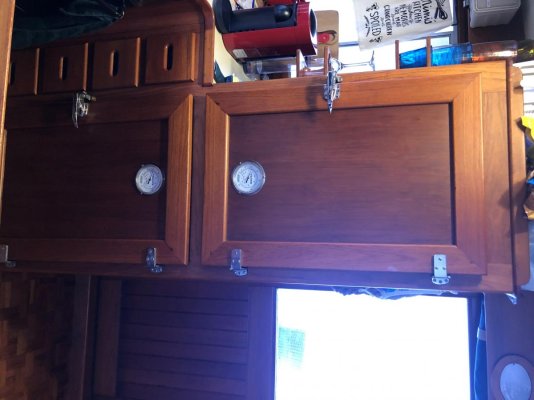Sure, I’d be happy to share my work, but I’ll need to explain a little about my specific GB configuration for it to make sense…. In my GB I have the freezer aft the port door and the fridge forward (the port door). I do not have an L configuration on my galley cabinetry. I also wanted to maintain the teak wood doors with the temp gauges that were delivered with the boat when it was new. Essential I wanted the salon to look “stock”.
My fridge/freezer system was completely operable when I started this modification. The main reason I undertook this project was my 3000w true sine wave inverter did not have the surge capacity to “start” the Grunert compressor, therefore, the only way I could “refreeze” or “recover” the cold plates would be on generator or shore power. My system would take more than a few hours of generator run time before the fridge/freezer temps to stay cool enough for me. After running longer voyages the heat from the engine room would cause me to run the generator for longer periods of time than I wanted to run to allow the fridge/freezer temps to recover. Plugging into shore power after voyages wasn’t an issue, but not every voyage of mine ends up in a marina.
I’m going to make the assumption that if you’re about to undertake a conversion you have a knowledge on how the Grunert system is configured with a single compressor and the solenoid valves/tubing to jointly run the system. Converting to a CoolBlue system required two compressors to make the system function. Specifically, one CoolBlue unit for the fridge and one CoolBlue unit for the freezer. In the completed form of my upgrade, the freezer and fridge both run independently now.
CoolBlue sells their systems as a set, meaning the cold plates, the copper line sets and the compressor, all recharged and ready to install, plug and play. Had I had access to all the required areas to install the CoolBlue systems, the two sets of CoolBlue systems would have been an easy install. In my GB’s configuration, cold plate mounting in the fridge is easy, replacing the Grunert compressor with the two CoolBlue compressors is easy, but the supply/return tubing, that’s different. Access to the bottom of the fridge, in the engine room, is not a problem for the tubing runs. However, the freezer is directly above the port fuel tank and there’s only about an inch of space rendering it completely inaccessible.
My solution was to cut the existing tubing below the refrigerator and splice in the new CoolBlue units into each tubing pairs (one pair for the fridge and one pair for the freezer) and leaving everything on the cold box side of both of those splices as original from GB. I didn’t touch anything after the splice, meaning the inaccessible freezer tubing, each temperature controls, each TXV valve, each cold plate…. All I had to do is run new 12V DC wiring from my house bank with the associated breakers, install the two CoolBlue compressors and splice the tubing together (re the sketch). I did have to vacuum down each of the systems after the the configuration was complete, and bring the 134 charge to proper levels.
I did not purchase CoolBlue’s cold plates or copper line sets (I did need to buy an adapter to attach the vacuum pump). I did not remove the cold plates at all.
I really like this system, and it has reduced my boating issues significantly while maintaining that gorgeous stock look.
View attachment 120594

